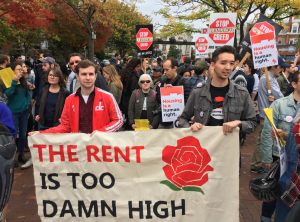Volunteers shivered as they circled Glover Park, scanned dark alleyways, and scoped out Georgetown’s canal for the second time that night. Ahead, a group of bodies sits perched on a pile of cardboard. Instead of passing by in awkward silence, a volunteer approaches the encampment, sits down cross-legged next to one of the men, and asks “Hello, sir! I am a volunteer for the PIT count; would you be willing to answer some questions for a $10 gift card?” The man sits up, nods, and begins to talk.
Georgetown’s Center for Social Justice (CSJ) participated in the annual Point-in-Time (PIT) national count by surveying the unsheltered homeless population in the Georgetown neighborhood. Groups of volunteers completed routes twice from 10 p.m. to 2 a.m. on Jan. 23. The night of the PIT count was also under a hypothermia weather alert due to temperatures under 32 degrees Fahrenheit, so volunteers used the count as an opportunity to offer socks, hats, gloves, bottled water, and transport to warming stations and emergency shelters for homeless individuals.
Every January, an army of volunteers searches city streets, parks, and suburban areas across the country as part of the PIT count to gather data on homeless individuals and their living conditions. In 2017, approximately 554,000 people in the United States were homeless on any given night, and rates of national homelessness are increasing steadily. The PIT count is currently the foremost national source of information to combat a rising homelessness crisis, but is not without its problems.
Erica Menino, a student in the Nursing Masters program, volunteered with the CSJ census team for the first time this year. For her, the PIT count is the first step toward understanding more about the homeless population and advocacy efforts. “This is an important way to get a handle on the state of homelessness and the conditions people are living in,” Menino said. “To have a good argument for increased resources for homelessness.”
The data produced by the annual count, which began in 2001, is provided to Congress to determine the amount of funding for federal, state, and local homelessness prevention programs. The U.S. Department of Housing and Urban Development requires all continuums of care, local bodies that receive funding for serving homeless populations, to report these annual survey results.
Lindsey Allcock, also in the Nursing Masters program and a volunteer with the university’s homelessness outreach programs since 2012, remarked that data collection is crucial to understanding the full breadth of America’s homelessness crisis.
“It is incredibly important to know how big a problem this is. In order to know what is going on in the District and the country, we need to have an accurate count,” Allcock said.
Brianna Ledsome, the director of the CSJ’s Homeless Outreach program, explained that the PIT count is not just about funding, but helping communities combat homelessness at the local level. “Point-in-Time counts are important because they establish the dimensions of the problem of homelessness, and help policymakers and program administrators track progress toward the goal of ending homelessness,” she said.
To figure out demographic data, the PIT survey asks willing participants about the number of individuals in their household, how long they’ve experienced homelessness, their age, gender and sexual orientation, race and ethnicity, and veteran and employment status. These questions are not nationally standardized, and some communities may only count the homeless population without collecting more in-depth data.
When individuals are unable or unwilling to complete the survey, volunteers report the answers to the best of their observable knowledge, Ledsome explained. They make assumptions about whether the person qualifies as homeless in the first place, as well as their age, race, gender, and other identifiable characteristics. However, Ledsome has found that, in several instances, survey participants are more willing to talk once they are made to feel comfortable.
“Immediately you are going to identify yourself as a volunteer. The first five words automatically change the demeanor of the conversation,” she said. “You are not a random person in Georgetown who is going to call the police on someone for experiencing homelessness. You are not going to criminalize their experience.”
The 2020 PIT census comes at a time of particularly tense relations between the District and its homeless population, with the forced displacement of homeless encampments in the NoMa neighborhood. Individuals experiencing homelessness may find their tents and property removed by police or be ordered to find a new place to sleep.
“Unfortunately, the relationship between the city government and police with folks experiencing homelessness is incredibly tense now,” Ledsome said. “If not more than ever because of the encampment clearings that are happening across the city.”
In addition to those living unsheltered on the street, the PIT survey tries to count all those affected by clearings and living in ninety-day emergency shelters or transitional housing. Unsheltered populations include people spending the night out-of-doors, in vehicles, or in substandard buildings considered unsafe for human habitation. The 2019 PIT count findings indicated that 6,521 people were experiencing homelessness in the District on Jan. 22. Of this group, 4,679 were in emergency shelters, while 1,234 stayed in transitional housing programs and 608 had no shelter at all.
While the PIT count attempts to provide accurate quantitative data, homelessness is more difficult to define than the survey might suggest. Allie Jania, a systems analyst and quality assurance specialist at Cherry Street Mission Ministries, argued that the PIT system fails to account for a large number of people experiencing homelessness nationally.
“Due to the transience of the population we serve, it does not break down the specifics. They could be here 360 days a year but because they are not here that one day, they are not counted,” Jania said. The fact the count is conducted in January, with the 2020 count conducted in hypothermia temperatures, may also cause miscounts as individuals are likely to be couch surfing on colder nights.
“They estimated that among 1,700 folks were couch surfing the night of the PIT count in 2019, so maybe they were surveyed the next day or maybe they were not surveyed at all,” Ledsome said.
Another limitation of the PIT count is the self-reported nature of the survey. While the CSJ’s survey offered responses for multiple gender identities, some organizations that conduct the survey only allow individuals to identify as male or female, which can exclude or miscategorize transgender and nonbinary individuals. “Since a lot of these organizations are Christian-based, people are trying to put them into their own boxes,” Jania said.
The survey also asks about a variety of sensitive topics. The survey inquires if the individual has faced domestic abuse. Other questions may include whether the individual is suffering from mental illness, disability, addiction to alcohol or drugs, or has ever resided in a government institution such as prison, rehab, or a mental health facility.
“We are asking all these people very personal questions, about potentially traumatizing and triggering things. As someone who has worked with psych patients in recent years, I still don’t feel fully trained to deal with these things,” Allcock said. “Yes, we can offer them resources, but we are leaving within ten to fifteen minutes of interacting with this person.”
The PIT census has taken steps to update its system in recent years. The survey has added a component to add physical descriptions and locations in order to follow up with individuals and offer resources.
Jania worries that the PIT count, despite its goal of combatting national homelessness, is struggling to count the people who need to be represented the most. “One thing is that we never receive that data back,” she said. “So while the PIT count may be gathering useful information, we still do not really know the demographics of the local community we serve.”
However, the data the PIT census collects aids communities in combating their homelessness crisis. Even those not required to participate, such as Cherry Street Mission Ministries, will submit their information because they know the information from the count will increase community resources that bring real help to those experiencing homelessness.




